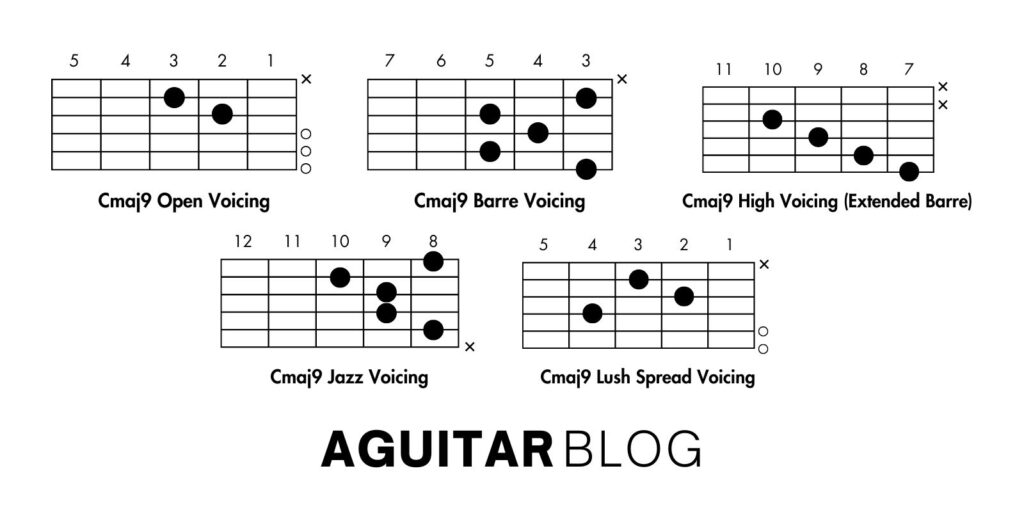The Cmaj9 guitar chord (C major 9th) is a beautiful, lush-sounding chord that adds complexity and richness to your playing. It’s commonly used in jazz, pop, and even neo-soul, and it creates a dreamy, open sound. In this guide, you’ll learn how to play the Cmaj9 chord, common mistakes, tips, variations, and more.
What is a Cmaj9 Guitar Chord?
The Cmaj9 chord is a major chord with added extensions, specifically a major seventh and a ninth. The ninth note (D) adds depth and sophistication to the basic C major chord. It creates a sense of openness, making it ideal for smooth, flowing progressions.
Cmaj9 Formula:
- Root (C)
- Major third (E)
- Perfect fifth (G)
- Major seventh (B)
- Ninth (D)
How to Play the Cmaj9 Guitar Chord

The Cmaj9 chord combines warmth and brightness, making it versatile for jazz, pop, and romantic music. Each variation offers unique tones suited for different styles, from open, resonant voicings to intricate jazz textures.
Cmaj9 Open Voicing
This variation provides a warm and open sound, perfect for soft ballads or gentle accompaniment. The ringing open strings add a natural resonance, making it ideal for acoustic settings.
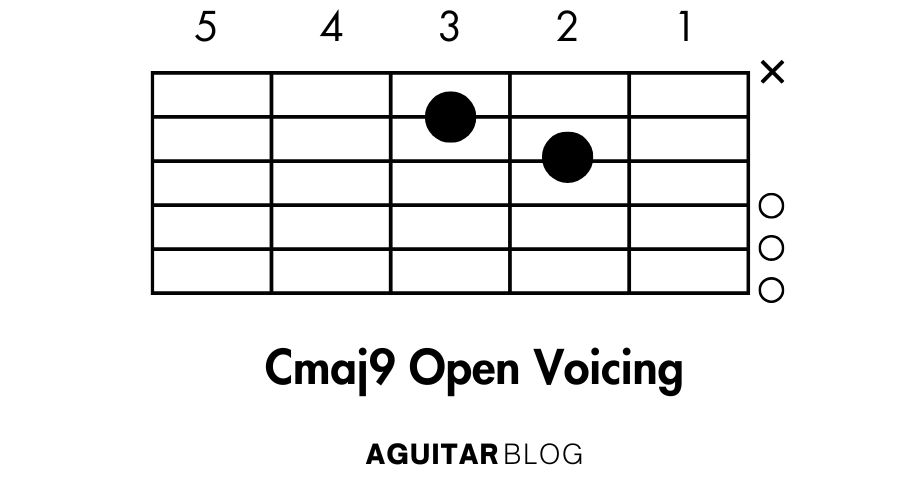
How to Play:
- Place your middle finger on the 3rd fret of the A string (C note).
- Place your index finger on the 2nd fret of the D string (E note).
- Leave the G, B, and high E strings open.
- Strum only the A, D, G, B, and high E strings for a full, ringing chord.
Cmaj9 Barre Voicing
This variation has a smooth and balanced tone, suited for jazz or pop contexts. The fretted notes give it a precise and controlled resonance, with an air of sophistication.

How to Play:
- Barre the 3rd fret across all strings with your index finger.
- Place your ring finger on the 5th fret of the D string (G note).
- Place your middle finger on the 4th fret of the G string (B note).
- Place your pinky finger on the 5th fret of the B string (D note).
- Strum from the A string for a full-bodied sound.
Cmaj9 High Voicing (Extended Barre)
This variation offers a shimmering, delicate sound, great for atmospheric or intricate arrangements. Its higher pitch makes it stand out in dense musical textures.
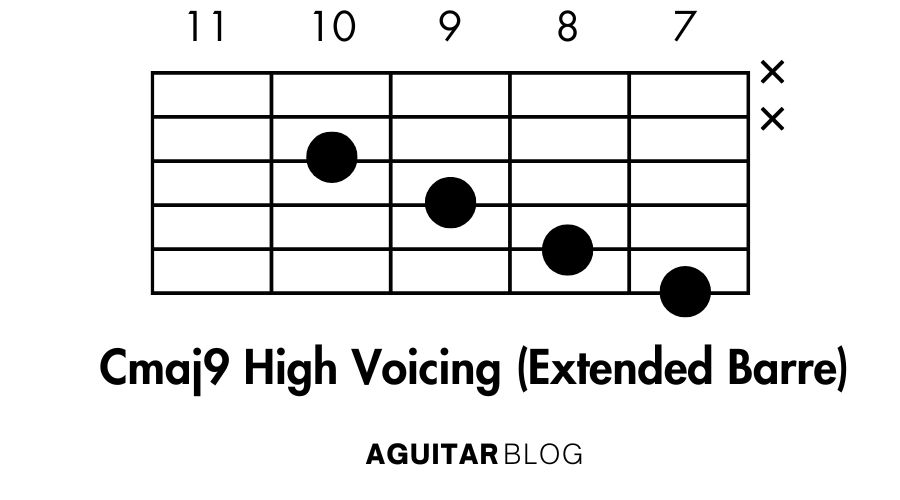
How to Play:
- Place your index finger on the 7th fret of the high E string (B note).
- Place your middle finger on the 8th fret of the B string (D note).
- Place your ring finger on the 9th fret of the G string (E note).
- Place your pinky finger on the 10th fret of the D string (C note).
- Strum only the D, G, B, and high E strings for a bright, ethereal tone.
Cmaj9 Jazz Voicing
This variation provides a rich, jazzy flavor, with its compact shape emphasizing the 9th interval. It’s versatile for swing or bebop settings.
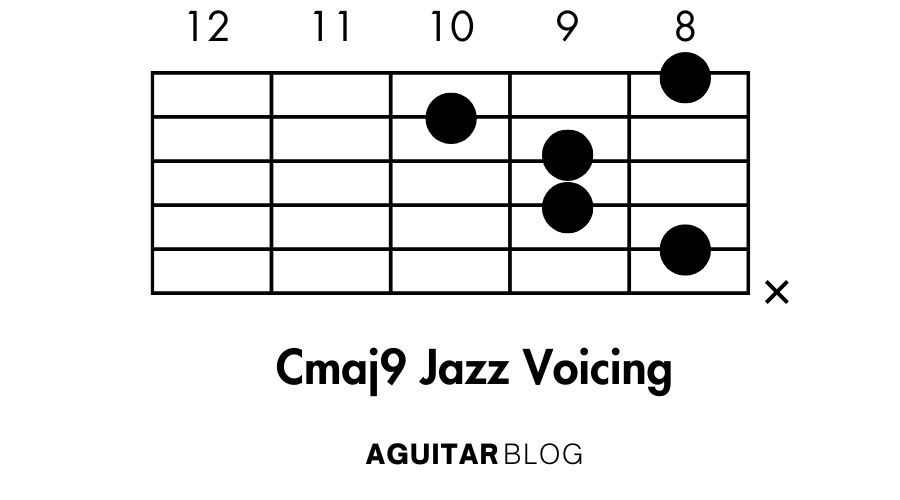
How to Play:
- Place your index finger on the 8th fret of the low E string (C note).
- Place your ring finger on the 10th fret of the A string (G note).
- Use your middle finger to fret the 9th fret of the D string (E note).
- Barre your index finger slightly to also fret the 8th fret of the G string (B note).
- Strum only the low E, A, D, and G strings for a smooth, jazzy chord.
Cmaj9 Lush Spread Voicing
This lush voicing creates a dreamy and expansive sound. It’s great for cinematic or ambient music, filling the sonic space with harmonic richness.
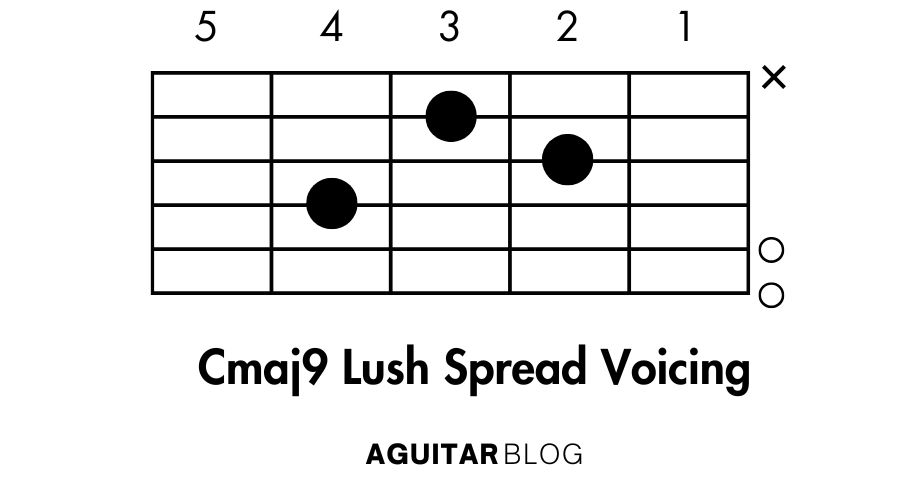
How to Play:
- Place your middle finger on the 3rd fret of the A string (C note).
- Place your index finger on the 2nd fret of the D string (E note).
- Place your ring finger on the 4th fret of the G string (B note).
- Leave the B and high E strings open for added resonance.
- Strum from the A string downward for a full and spread-out chord.
Top Songs Featuring or Suited for Cmaj9 Chord on Guitar
The Cmaj9 chord adds warmth and sophistication to any piece of music, and it’s widely used in genres like jazz, pop, and soul. Below is a detailed list of songs where Cmaj9 fits beautifully, with explanations on how it complements the music and where you can play it.
“Gravity” – John Mayer
Why It Works:
“Gravity” is built around soulful and smooth progressions. The Cmaj9 chord adds a rich, jazzy tone that elevates the emotional depth of the song.
How to Use:
- Substitute Cmaj9 for Cmaj7 in sections where the song needs a more delicate and expressive texture.
- For example, during the chorus, you can use Cmaj9 → Am7 → D7sus4 → G for a lush progression.
“Every Breath You Take” – The Police
Why It Works:
This song’s arpeggiated chord structure and airy sound make it ideal for the shimmering resonance of Cmaj9.
How to Use:
- Replace C major chords in the verses with Cmaj9 for a smoother, more atmospheric feel.
- Suggested progression: Cmaj9 → G → Am → Fmaj7 to enhance its dreamy quality.
“Tears in Heaven” – Eric Clapton
Why It Works:
Known for its gentle and emotional melody, the Cmaj9 chord can make the chord progression sound more heartfelt.
How to Use:
- Play Cmaj9 → G/B → Am → Fmaj7 during the verses for a softer tone.
- Strumming gently or fingerpicking will highlight the warmth of Cmaj9 in this ballad.
“Imagine” – John Lennon
Why It Works:
The original uses Cmaj7, but substituting with Cmaj9 gives a slightly more modern and ethereal tone.
How to Use:
- During the intro and verses, play Cmaj9 → F → Cmaj9 → F.
- This small change adds a layer of sophistication to the classic piano-driven progression.
“Isn’t She Lovely” – Stevie Wonder
Why It Works:
The jazzy vibe of this song pairs perfectly with extended chords like Cmaj9, making it richer and more vibrant.
How to Use:
- Use Cmaj9 as the starting chord in the main progression: Cmaj9 → Dm7 → G7 → Fmaj7.
- The upbeat strumming patterns complement the bright tones of Cmaj9 beautifully.
“Blackbird” – The Beatles
Why It Works:
While the song uses unique voicings, adding Cmaj9 as a substitute for C major creates a more lush harmonic base for its fingerstyle melody.
How to Use:
- Replace any C chord in the verses with Cmaj9 to give the arpeggiated sections more resonance.
- Suggested progression: Cmaj9 → A7 → Dm7 → G7 for a fingerstyle variation.
“Something” – The Beatles
Why It Works:
This song’s rich harmonic layers thrive on extended chords. Adding Cmaj9 can enhance its romantic and sophisticated feel.
How to Use:
- Replace standard C chords in the chorus or verses with Cmaj9.
- Suggested progression: Cmaj9 → Am7 → D7 → G for a more expressive and contemporary sound.
Incorporating the Cmaj9 chord into your playing can elevate your sound, adding depth and sophistication to your music. Whether you’re strumming heartfelt ballads or crafting intricate jazz melodies, this versatile chord is a must-have in any guitarist’s repertoire. Explore these top songs, experiment with your style, and unlock the full potential of your guitar skills.
For more tips, detailed guides, and song tutorials, stay tuned to AGuitar Blog—your ultimate resource for mastering the art of guitar playing.
SEE ALSO RELATED C CHORDS

